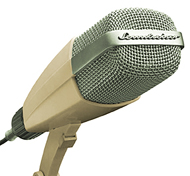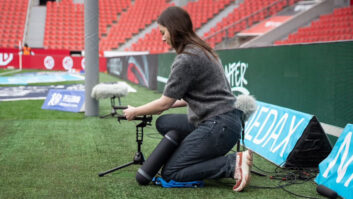
When the subject of half-century-old classic microphones comes up, images of condenser microphones—rather than dynamic designs—usually comes to mind, especially when considering mics that are still workhorses in studios and onstage. But now, celebrating its 50th anniversary, the Sennheiser MD-421—the MD stands for mikrofon dynamische—is an example of a classic dynamic that’s just as useable today as it was on its debut in 1960.
Some 50 years after its debut, the Sennheiser MD-421 still remains a favorite mic for drums, horns, guitar cabinets and vocals.
The Predecessor
Introduced in seven years earlier, in 1953 Sennheiser’s MD-21 dynamic microphone was perhaps one of the company’s most successful products. Rugged, reliable, good sounding and available in available in five colors, it was a hit with European broadcasters and remained in production for decades.
However, the basic, no-frills MD-21 was an omnidirectional model, so in 1959, company founder Dr. Fritz Sennheiser worked with design engineers Paul-Friedrich Warning and Johann-Friedrich Fischer to take the design to the next step.
The New Mic on the Block
The project was the MD-421, a rugged dynamic mic that could provide a tight cardioid directivity pattern that was consistent at nearly all frequencies. It also featured the capability to handle extremely high sound pressure levels (up to 175 dB!), a hum compensation coil to prevent EMI/RFI interference and a 5-step low-frequency attenuation circuit for tweaking bass response.
The MD-421 had to provide studio-quality frequency response (30 Hz to 17 kHz) and be able to be manufactured in relatively large quantities. It was a tall order, but the development team went to work.
In most studio (or live sound) mic designs, the capsule and electronics are the most difficult part of the design process, but with the MD-421, extreme attention was also paid to controlling low frequency directivity and assuring consistent polar response. This was accomplished using four rear vents near the rear of the mic, felt damping at the rear of the mic body, internal damping within the capsule and a bass pre-emphasis tube that provided airflow between the capsule interior and a large air chamber within the mic body. The cutaway diagram of the MD-421 reveals the complexity of a design that resembles a jet engine more than a dynamic microphone; download a cutaway diagram of the MD-421, which offers a look into the complexity of the MD-421 design with multiple air chambers, venting tubes and dampening material used inside the body cavity.
The MD-421’s body was made of DuPont Delrin polymer resin, which had just become available the year before, and 50 years later, the MD-421 remains one of the few professional audio microphones featuring a molded (now glass composite) body.
The MD-421 was launched at Germany’s Hannover Fair in 1960 and carried a price tag of 180 Deutschmarks (about $45 USD). The original version was available with Tuchel or DIN output connectors; an XLR version followed years later.

At one point, backorders for MD-421s were so severe that Sennheiser ran ads featuring this baker posing with fresh mics coming out of oven to assure customers that more were on the way.
But in any version, the MD-421 was an instant success. In fact at one time, the backorder situation was so extreme that Sennheiser ran ads with a bakery worker posing with trays of mics coming out of the oven, to assure customers and dealers that more MD-421s were on the way.
The Present and Beyond
Today, five decades years after its introduction, the MD-421 remains in use worldwide in broadcast as a vocal microphone and in studios mostly as an instrumental microphone capturing percussion, drums, guitar amps and horns. The current incarnation of the MD-421, the next-generation MD-421-II, incorporates improvements such as a metal inner chassis for better weight distribution, a shorter, sleeker housing and self-sealing (non-adhesive) acoustic connections for improved serviceability. And with some 500,000 units in use since 1960, the MD-421 has definitely earned the well-deserved distinction of an audio classic.
Read about the current Sennheiser MD-421-II.
George Petersen’s most recent recording project is Chelle and Friends’ Voodooville, a surround-audio DVD of New Orleans funk/blues/jazz.Read George Petersen’s blog about producing Voodooville in surround.







